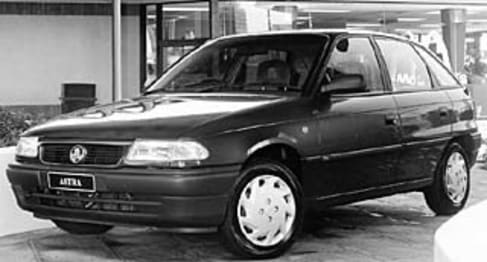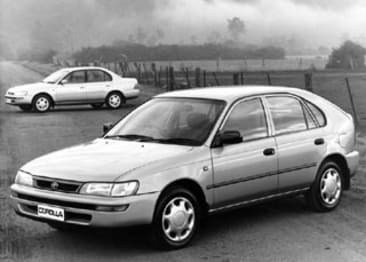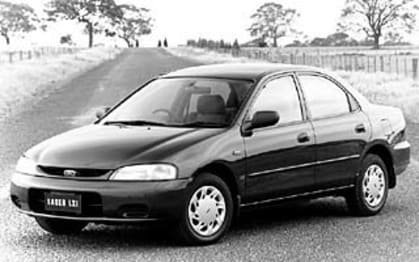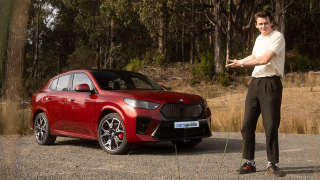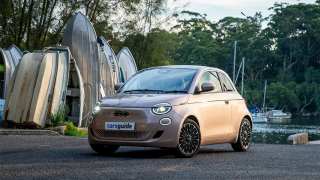
Used Holden Astra review: 1996-1998
- Holden Astra
- Holden Astra 1998
- Holden Astra 1996
- Holden Astra 1997
- Holden Astra Reviews
- Holden Reviews
- Holden Hatchback Range
- Holden Sedan Range
- Hatchback
- Sedan
- Holden
- Used Car Reviews
- Small Cars

What we like
- Robust and reliable
- Plenty of space
- Good ride and handling
What we don't
- Only has the bare basics
- Lots of road noise
- Very old
What we like
- Robust and reliable
- Plenty of space
- Good ride and handling
What we don't
- Only has the bare basics
- Lots of road noise
- Very old
After several less than successful attempts to market small cars from other carmakers rebadged as its own, Holden turned to its European cousins at Opel for the German-designed Astra.
Before the arrival of the European TR Astra in 1996, Holden used the Astra badge on rebadged Nissan Pulsars, produced under an arrangement with the Japanese brand's factory in Clayton, Victoria.
After Nissan, Holden turned to Toyota and sold rebadged Corollas as Holden Novas.
Both deals were struck in times of trouble, when Holden was struggling to stay afloat in an increasingly competitive local market.
The switch to the European Astra helped revitalise the company's fortunes in the small car market.
Second only to the VW Golf in Europe, the front-wheel drive Astra was a success before it launched here.
Models
The range was made up of two body styles, a four-door sedan and a five-door hatch, and three models, which were enough to most needs.
The entry-level model was the City, which had a 1.6-litre engine, a choice of manual gearbox or automatic transmission, and was available in both body styles.
Typical of the time it only had the bare basics, which were central locking, power steering, intermittent windscreen wipers, and a radio/cassette plater with six speakers to distribute the sound.
Importantly it did have an airbag for the driver, but if you wanted an airbag for the front passenger you had to visit the options list and pay extra for it.

If you wanted air conditioning, it too was an option.
For more, there was the GL, which was available as a sedan or hatch, had a 1.8-litre engine, and the option of a manual gearbox or automatic transmission.
Being the mid-ranger it was better equipped than the lowly City, although it's list of standard features was nothing to write home about.
Over and above the City's meagre features list the GL gave you an engine immobiliser, front fog lamps, power mirrors, a tachometer, and body coloured bumpers.
Like the City it had a standard driver's airbag, but a passenger's airbag was optional, as was air conditioning.
For a more sporty drive Holden offered the GSi, a hot hatch with a 2.0-litre engine and a manual gearbox.
It boasted a number of features the others didn't have, like dual front airbags, an alarm, alloy wheels, sports front seats, and sports suspension tuning.
Like the City and GL air conditioning was optional.
All came with a full-sized spare wheel, but none had the option of a sunroof.
Being a product of the '90s the TR lacked features like Bluetooth, so it wasn't possible to sync an iPhone or Android device.
There wasn't a touch screen, the air conditioning wasn't automatic climate control, and there were no parking aids like a reversing camera, parking sensors, or a park assist system.
Cabin
Inside, the TR Astra was roomy, with plenty of space for four adults and luggage.
Rear seat room was particularly praised, as was its luggage capacity, which was boosted by a 60/40 split-fold seat.
Engine
Power came from a range of four-cylinder petrol engines, all tuned to local conditions by Holden engineers, and featuring multi-point fuel injection.
The base engine in the City was a 1.6-litre single overhead camshaft four-cylinder engine that produced 74 kW at 5800 rpm and 135 Nm at 3400 rpm at its respective power and torque peaks, delivering a blend of performance and economy.
A 1.8-litre four-cylinder engine powered the GL. This was produced by Holden in Australia and had twin overhead camshafts with four valves per cylinder. Peak power was 85kW at 5400rpm and maximum torque was 165Nm at 4000rpm.

The sporty GSi packed the biggest punch. With twin cams and 16 valves, it put out 100kW (135 horsepower) at 5600rpm and 188Nm at 3200rpm.
When pushed to the limit the GSi would account for the 0-100km/h sprint in a very creditable time of 8.4 seconds.
City and GL buyers could choose between a five-speed manual gearbox and an optional four-speed electronic automatic transmission.
But the only choice for those signing up for the hot GSi was the five-speed manual gearbox.
Driving
Under the skin was a well-proven platform; the front suspension was made up of MacPherson struts complete with a stabiliser bar and gas-filled shocks at the front, while the rear suspension consisted of a compound torsion beam axle with progressive-rate coil springs and gas shocks.
Holden engineers optimised spring rates, shock settings and the diameter of the stabiliser bar for each model.
Power steering was standard across the range, with the GSi getting a faster rack to give it a sharper, sportier feel.

Brakes were a combination of front discs and rear drums on the City, but the GL and GSi had four wheel discs, and the GSi had the added benefit of standard ABS.
The ride and handling were praised, as was the steering, which was direct and well modulated.
Road noise was a regular criticism of owners who complained that it was too high.
Safety
Safety wasn't yet cemented in mainstream thinking when the TR was launched, so the safety features were minimal by today's standards.
All models had a driver's airbag as standard, but a passenger's was only available as an option on the City and GL. The GSi was blessed with both as standard.
The only model with ABS braking, a given today, was the GSi.
'How Safe Is Your Car' rates the TR Astra as 'Good' based on real life crashes.
Lap/sash seat belts allowed for the fitment of a baby car seat, but the TR came long before the advent of ISOFIX mounting points.
Any common issues?
Reports from the trade suggest the Astra is robust and reliable, with few engine or transmission problems.
The one issue that affects the Astra is breaking cam timing belts. A broken belt can lead to serious, if not terminal, internal engine damage.
The service interval was 100,000km, but that was reduced to 60,000km after a number of owners experienced problems with broken belts.

It's crucial that the belt be changed as recommended; ignoring the change could be expensive.
Heavy brake wear is also an issue, so be prepared to replace the brakes more frequently than would normally be expected.
Other than those words of caution the TR Astra's reliability is quite sound, providing it has been regularly serviced.
Check for a service record that shows regular maintenance, and don't buy a car that appears to have been neglected.
Oil to be used is 10W-40.
Capped price servicing didn't apply to the TR, but service costs are not excessive.
When new the TR carried a three-year/100,000 km warranty, but that has long expired and no longer applies.
MORE: If anything crops up, you'll probably find it on our Holden Astra problems page.
Rivals
Toyota Corolla
Keeps on going when others fall away, but only buy if in tip-top shape.
Nissan Pulsar
Looking old and tired, risky buy.
Ford Laser
Was once a car to buy, but not now.
Verdict
Good in its day, but too old now.
Pricing guides
Range and Specs
| Vehicle | Specs | Price* | |
|---|---|---|---|
| City | 1.6L, ULP, 4 SP AUTO | $1,980 – 3,080 | 1996 Holden Astra 1996 City Pricing and Specs |
| City | 1.6L, ULP, 4 SP AUTO | $1,980 – 3,080 | 1996 Holden Astra 1996 City Pricing and Specs |
| GL | 1.8L, ULP, 4 SP AUTO | $2,310 – 3,630 | 1996 Holden Astra 1996 GL Pricing and Specs |
| GSi | 2.0L, PULP, 5 SP MAN | $2,640 – 4,070 | 1996 Holden Astra 1996 GSi Pricing and Specs |
Other cars to consider
$1,980
Lowest price, based on third party pricing data




